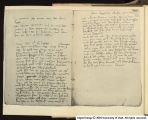| OCR Text |
Show 13 PAPERMAKIN free each sheet of paper from the interleaving felts and to place th sheets in a neat and even pile, one upon another, on an incline cloths were expensive and the old mills had but one set for eac size of paper that they made. By long hours and diligent work i was possible for the three workmen to make twenty posts, or abou five and one half reams of paper, a day. Had but a single moul used, one man acting as both vatman and coucher, scarcel one-fourth of this amount would have resulted After the sheets had been placed one upon another by the layman, the pile was again subjected to pressure, but with nothing between the sheets. This process, although of light pressure, brough out a litdle more water, which formed in drops upon the edges o the sheets. After this sccond slight pressing the sheets were separated, built in a pile again, but in different rotation, and subjecte t0 a little heavier pressure than could have been given before owing to the tendency of the sheets to stick together. This exchanging was repeated until the paper acquired the desire smoothness of finish. ‘The roughness of much of the paper previous to the sixteenth century would indicate that before that tim this exchanging or parting was not in practice in some localities the paper evidently having received no finishing after remova from the woolen felts. Tn an examination of old paper, especiall Tealian and Dutch, it will be noticed that many of the sheets retai the impressions left by the material upon which they were couched The carly American papermakers did not devote much time o labour to the exchanging, although this procedure was, and still s the secret of giving to handmade paper a beautiful finish and texure The next process, afier the exchanging, was the drying of th paper, which was one of the most particular operations of the mill Digital Imag © 2004 University of Utah. All rights reserved |



































































































































































































































































































































































































